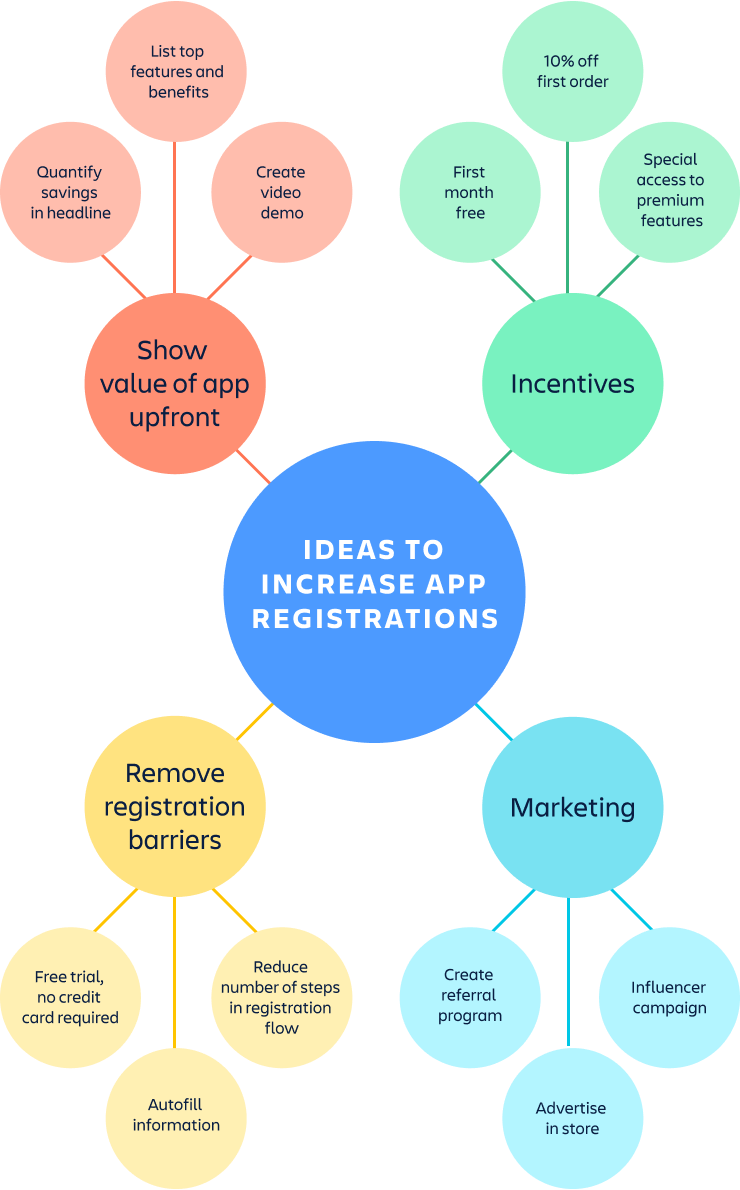5-second summary
- Divergent thinking is a creative process that generates new ideas through free-flowing, unstructured brainstorming. It encourages exploring any and all possibilities, rather than taking the fastest, straightest path to one answer.
- Divergent thinking is most effective when the people doing it feel safe, have the time and space to get inspired, collaborate with others, set expectations as a group, and warm up first.
- Using divergent thinking exercises can help you get started by providing a little structure and inspiration to a purposely unstructured process.
If you’ve ever come up with a name for a child, pet, or even a beloved plant or car, you’ve already engaged in divergent thinking. As you were thinking of names, you let your mind wander, imagining all the possibilities. You might have compared ideas with a loved one too. Perhaps one person was thinking of popular names like Emma and Ava, while your partner wanted a more unique moniker like Eowyn or Aurelia. Eventually, you converged on the perfect name to represent your bundle of joy (Elodie…unique, yet easy to say and spell!) – but only after you diverged and brainstormed without boundaries. That’s the power of divergent thinking.
What is divergent thinking?
Introduced by psychologist J.P. Guilford in 1956, divergent thinking is a creative thought process used to generate new ideas through free-flowing, unstructured brainstorming.
In a typical problem-solving or brainstorming session – people are often trying to find the most direct path to one “right” solution, often channeling “convergent” or “lateral” thinking. Divergent thinking, on the other hand, is unrestricted, judgment-free, and takes a meandering path to explore all viable (and some not-so-viable) options. There’s no right way to do it, and there are no wrong answers.
This approach offers a number of advantages:
- It allows you to see a problem or concept from many perspectives and angles.
- It produces more ideas to choose from.
- It encourages creativity and open-mindedness, which often lead to even better solutions.

Paving the way for creative collaboration
Divergent thinking unlocks new ideas and even better solutions at work – but only if the team and environment support it. These tips can help prepare your group for a successful session.
Foster a sense of psychological safety
Psychological safety, a term coined by Harvard researcher Amy Edmondson, is a shared belief held by members of a team that it’s safe to take risks. When people feel psychologically safe and know it’s ok to make mistakes, they’re more comfortable, more open to exploring new ideas, and more inclined to work together to find the best solution.
Set aside time and a new space
It can be hard for teams to be strategic and creative when they’re busy with day-to-day execution. Reserving a designated time for divergent thinking and changing up the environment – another conference room or even an off-site location – helps everyone get in the right mental and physical space to think differently.
Include 5 – 7 diverse collaborators
Approaching your attendee list like Goldilocks will help make sure the group isn’t too big or too small, but rather, juuuuust right. Research shows brainstorming sessions are most efficient when they include five to seven people: big enough to generate enough ideas, but not so big that it becomes unwieldy.
Inviting people with diverse perspectives can also help ward off groupthink, when people abandon their own beliefs to conform with the group. Diversity could be represented in the form of different disciplines (e.g., design or development), departments (e.g., Sales or Product), critical thinking perspectives (e.g., front-line, functional expertise, or creative/innovator), identities (e.g., culture or gender), etc.
Set expectations for the team with mutual agreements
Divergent thinking is most effective when participants are focused, open, and collaborative. Creating mutual team agreements and expectations (e.g., put devices aside, share all ideas that come to mind, suspend judgment, and build on others’ suggestions) can support the group in being efficient and effective.
Start with a warmup
Like warming up your body before exercising, warming up your mind before brainstorming gets you in the right headspace and primes your brain for creativity. Warmups can be more structured, like these icebreaker activities, or more free-form, like listening to music or drawing.
6 divergent thinking exercises for brilliant brainstorming
Now that the team feels safe, focused, and warmed up, it’s time to let their creativity loose! Here are a few exercises to help get started.
We’ll use the following example to see how each divergent thinking exercise would be applied in a problem-solving brainstorm.
Problem statement: “Registrations for our new grocery shopping app have plateaued. We want to increase registrations by 25% within one year.”
1. Freewriting
Freewriting is the ultimate free-association activity – you simply write words, phrases, sentences, diagrams, doodles, whatever without stopping, and without worrying about spelling, mechanics, drawing skills, or the feasibility of an idea. There are no wrong answers and no constraints (aside from time, if you choose to set a timer).
If your team works best with a bit more structure, you can try 6-3-5 Brainwriting, where six people each write three ideas on a sheet of paper as many times as they can during a five-minute round. Then, they pass their sheets to the next teammate, who spends the next five minutes adding to the other person’s ideas.
Freewriting in action: Each team member starts with the word “registration” and writes any words that come to mind, such as:
| Sign up | Happiness | Smiles |
| Signs | Surprises | Rewards |
| Looking up | Excitement | Incentives |
| Optimism | Delight | Positive reinforcement |
The team could then expand on certain ideas or themes for more specific solutions, such as ways you can add delight to the registration process or rewards you could offer for signing up.
2. Mind mapping
A mind map builds new ideas off one central concept or subject. After writing down the primary concept, teams brainstorm supporting ideas, tasks, and questions around it. Then, they repeat the process for each of the secondary concepts, then the tertiary concepts, etc. The result is an organized diagram that shows lots of new ideas and how all of them are linked.
Mind mapping in action:

With all of these ideas mapped out, the group could then converge and narrow down which ones should be prioritized based on the impact they could have on registrations vs. the effort they would take to implement.
3. Disruptive brainstorming
Disruptive brainstorming reveals new solutions by introducing hypothetical constraints. After brainstorming one set of ideas, teams use Disrupt Cards to look at the same problem or question from a new perspective. After diverging, each group converges on the ideas that are most achievable, supportable, and relevant, then assigns owners to investigate how to bring each one to life.
Disruptive brainstorming in action:
The team brainstorms one set of ideas for increasing registrations. Then, they pick the “Scarcity” Disrupt Card and brainstorm how they might apply scarcity to boost registrations even more, such as limiting signups to 100 per day and displaying the number available in real time next to the “Register” button.
Once the brainstorming session comes to a close, they cut the ideas that aren’t doable or aligned with the product strategy, and assign owners to the rest to begin the planning process.
4. Alternate Uses
Designed by J.P. Guilford in the 1960s, the Alternative Uses Test is a way to generate creative ideas and solutions from a single concept or piece of information. This approach can help look at something familiar from a new perspective.
Alternative Uses Test in action:
What might be alternative ways to learn about our grocery shopping app and sign up for it? (Wacky ideas welcome!) Sample answers:
- Scanning a QR code in the grocery store
- Mail a welcome kit to new parents with a promo code to try the app
- App mascot hands out flyers outside dorms during college move-in days
- Guerilla marketing campaign where we put stickers on grocery store doors that say, ”We could have saved you this trip.”
- Professional skydivers spell out the app name above the Super Bowl (we meant what we said: no bad ideas)
Then, the team could either build on a few of the most promising ideas or filter some of the more granular concepts that might be more feasible.
5. Collaborative drawing and storytelling
Collaborative drawing and storytelling (also known as a “one-word story”) expand on others’ ideas spontaneously. One person writes one word or starts a drawing. Then they pass it to another person, who adds the first word or drawing that comes to mind, and so on. The team repeats this process until there are enough potentially viable ideas to begin narrowing down and planning next steps for the best concepts.
Collaborative storytelling in action:
We could increase registrations by…
| Person 1’s answer | sharing |
| Person 2’s answer | 3D |
| Person 3’s answer | video |
| Person 4’s answer | walkthroughs |
| Person 5’s answer | on |
| Person 6’s answer | TikTok (Sounds silly, but hey, we’ve seen stranger things go viral!) |
Even if the team ends up moving forward with a scaled-down concept or alternative plan, going through the exercise is a great way to uncover outside-the-box ideas.
6. Yes, and…
A core tenet of improv comedy, “Yes, and…” encourages open-mindedness and exploration by accepting any scenario that is presented, then adding to it. When one person shares an idea, another person immediately embraces it and adds something that takes it to the next level.
“Yes, and…” in action:
Person #1: “We could show the average time the whole process takes on the first screen so users see it’s fast.”
Person #2: “Yes, and we could put a completion tracker at the top of each registration screen so they see where they are in the process.”
Person #3: “Yes, and we remove any unnecessary steps from each screen to make the process even faster.”
From naming babies with your partner at home to developing new ideas and solutions with your team at work, divergent thinking is a powerful way to stimulate creativity and uncover new possibilities. Like any new thought process or method, your team may feel a bit unsure about how to do it or where to begin. But just because divergent thinking is free-form doesn’t mean it’s a free-for-all. With a little preparation and a few exercises to get the momentum going, you can add just enough structure to a purposely unstructured process and set your team up for a brilliant brainstorm.
Ready to try it? Yes, and…let’s get started!





 )
) 






































